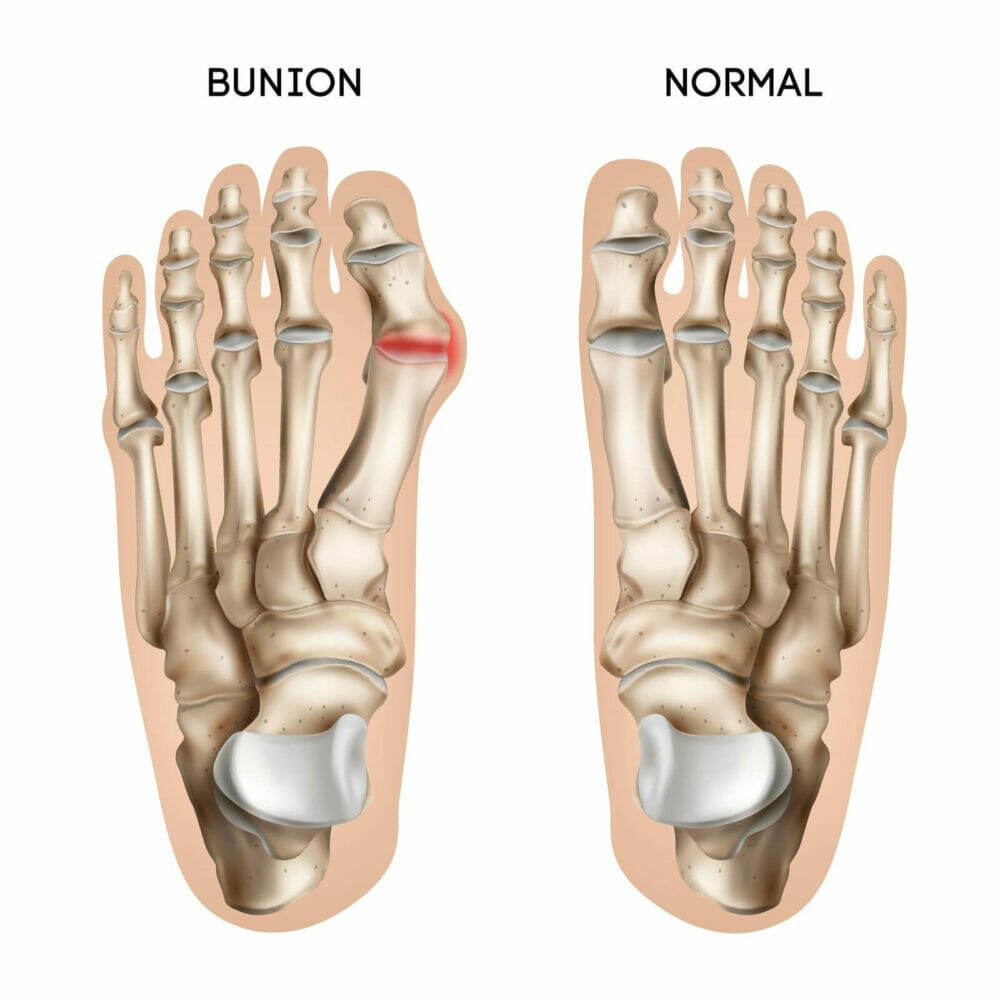foot health care
15 Best Ways to Treat Bunions Without Surgery
Bunions are a common foot deformity that can cause pain and difficulty walking. Bunion’s pain can be unbearable! It should not be left untreated as it can lead to further deformity of the foot and the development of other problems such as arthritis, joint damage, Metatarsalgia (pain in the ball of the foot), and hammertoe.
If you are suffering from bunions, you might be thinking about getting surgery. But is bunion surgery your only option? Or are there non-surgical ways to treat your painful bunion? Although surgery is the most effective way to treat bunions, it is expensive and may not be the best option for everyone.
The good news is that there are many non-surgical treatments that can help relieve bunion pain and improve toe alignment. Below we will explain the 15 best ways to treat bunions without surgery and help you find the best treatment for your bunion condition. Unlike surgery, these bunion treatments are very affordable and can be done at home.
How common are bunions?
Bunions are very common. One-third of Americans, mostly the female and older population, suffer from this condition. Some have it on one of their feet while others have them on both.
How to know if you have a bunion?
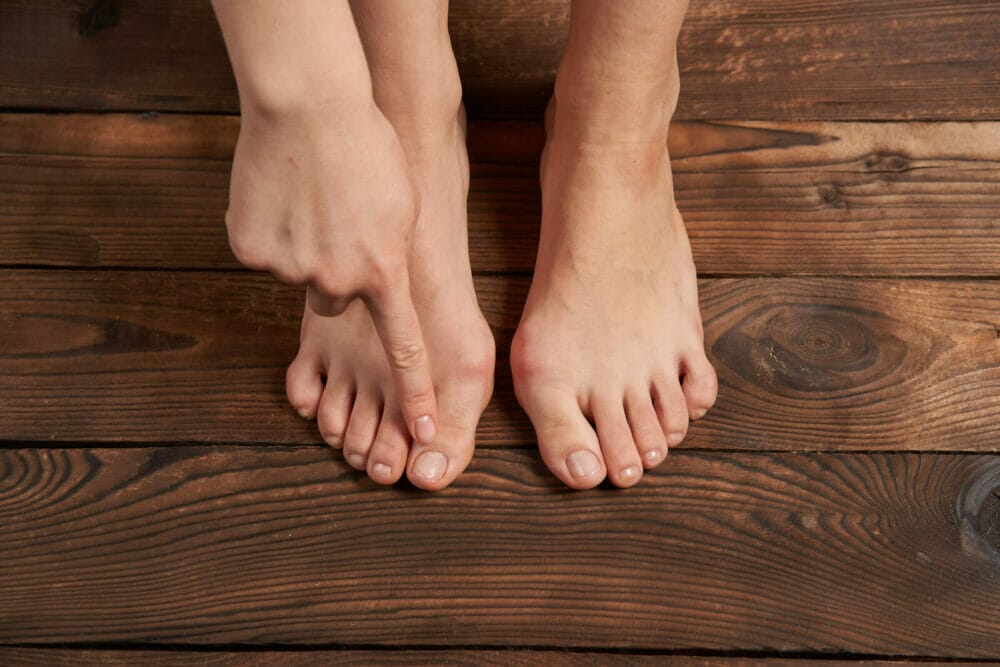
Not all bunions hurt so some people may not know that they have it unless it is irritated, inflamed, or becomes uncomfortable. You might be unaware that the bulging bump on the outside base of your big toe is already a bunion.
Other obvious signs and symptoms also include swelling or soreness around your big toe joint, rubbing of your big and second toes, limited movement of your toes, and pain that either stays or comes and goes.
What causes bunions?
Experts believe the bunions are genetic. While the bunion itself is not inherited, it is often caused by an inherited faulty mechanical structure of the foot.
Some existing foot conditions can also put a person at risk of developing bunions such as having a flat foot as it may exaggerate the force that pushes the big toe to deviate medially. Individuals with rheumatoid arthritis or other connective tissue disorders are also prone to bunions.
What are the Bunion Stages?
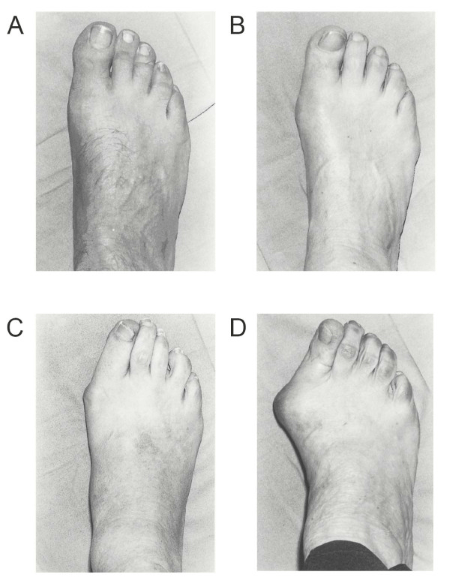
As shown above, there are 4 stages of bunions:
A – Grade 1 – no deformity
B – Grade 2 – mild deformity
C – Grade 3 – moderate deformity
D – Grade 4 – severe deformity
What happens if a Bunion is left untreated?
As long as they don’t hurt or become uncomfortable, many people lived with bunions without it affecting their daily lives. But as bunions grow in size, they can get worse and you might experience inflammation, pain, and discomfort. Your big toe joint may sustain extensive and long-term damage as it could cause the cartilage in the joint to deteriorate.
Can Bunion Pain Be Treated Without Surgery?
Surgery is not always the solution and a lot of people with bunions don’t necessarily have to go through surgery. On certain occasions, a podiatrist might suggest surgery. But depending on the condition and pain level of your bunion, a non-surgical treatment might be all you need.
What are the Different Types of Bunions?
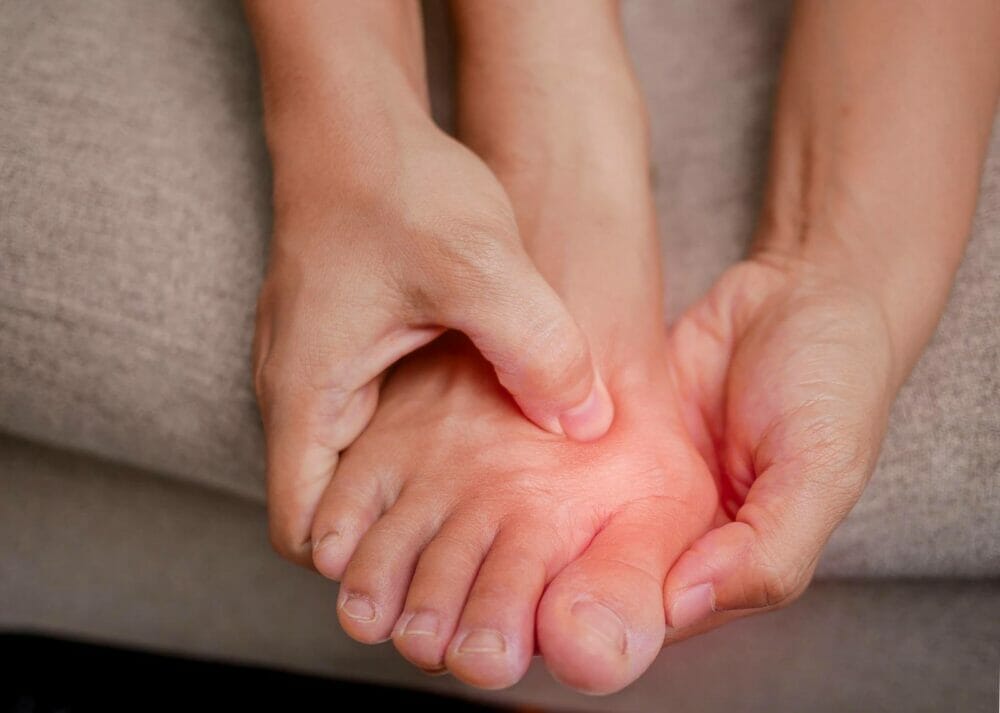
The following are some of the most common types of bunions a person can get:
- Tailor’s bunion – also known as bunionette, this type of bunion develops in the pinky toe instead of the big toe. As it grows, the tailor’s bunion can cause your pinky toe to change direction and protrude.
- Large bunion – bunions can develop in different sizes and shapes. When it becomes too larger, you may find it difficult to purchase suitable footwear. You could also develop and experience more symptoms and discomfort.
- Congenital Hallux Valgus is a very rare condition where a fetus or newborn baby shows a lateral deviation of the first toes.
- Juvenile or Adolescent Hallux Valgus – this is when a teenager between 10-15 years old develops a bunion.
- Bunion with Hallux Limitus – this condition is also known as hallux rigidus. This type of bunion limits the flexibility of the big toe joint. Since it causes big toe jamming, this bunion often develops at the top of the big toe’s joint instead of on the side.
- Bunion with Skin Irritation – having skin irritation is common for individuals with bunions, especially those who wear tight and closed shoes. The shoe’s tightness and the protrusion at the big toe can cause skin friction and irritation, which often lead to peeling, redness, and wound. To prevent infection or serious wounds, you must always clean and moisturize your feet and treat any skin issues that you have.
Will Bunions Go Away Without Treatment?
Unfortunately, bunions are irreversible and they don’t go on their own. Once you get one, most likely that it will grow over time. Some bunions may develop and grow slowly over years. But they can become painful and could lead to complications over the years. At this time, a treatment either non-surgical or surgical is necessary to relieve the pain, swelling, and other symptoms associated with it.
How to Treat Bunions Without Surgery
Over the years, doctors were able to develop various non-surgical treatments to get rid of bunions or manage the symptoms related to them. Among these non-surgical treatments include orthotics, oral anti-inflammatory medications, topical creams, and exercises.
Here are the best non-surgical bunion treatments
- NSAID – short for Non-steroidal anti-inflammatory drugs are also recommended by doctors to help reduce inflammation and relieve pain in the foot affected by the bunion. Some of these medications such as naproxen and ibuprofen can be taken without a prescription.

2. Choose the right footwear – your footwear can either help you manage your bunion or hasten its progress and worsen the bunion symptoms. That is why it is important to choose the right footwear.
3. Wear shoes with round and wide-toe boxes – since these types of shoes have ample room for your toes, they can reduce the pressure on your bunion and help you walk comfortably and pain-free.
4. Avoid high-heeled and pointed shoes – these shoes can crowd your toes, aggravate bunion development, and push the bunion and big toe further out of place.
5. Exercise and stretching – certain toe stretches and foot exercises can help in mobilizing your big toe and the rest of your foot. They can also help maintain flexibility and strengthen the muscles controlling your big toe.
6. Bunion pads – the bunion treatment pads come in different styles and are available for purchase over the counter or online. At HealthDevice.com, you will find a variety of high-quality bunion pads at affordable prices. Among the most popular types of bunion pads is silicone sleeves that are worn inside the shoes to cushion the bunion. There are also toe spacers to help separate and align the big toe and second toe.
Recommendations: Pedifix Visco-gel Bunion Relief Fabric Sleeve, PediFix Visco-GEL Toe Spacers, PediFix Bunion Relievers, Pedifix Visco-GEL Dual Action, and PediFix Pedi-GEL Bunion Shield
PediFix Visco-gel Bunion Relief Fabric
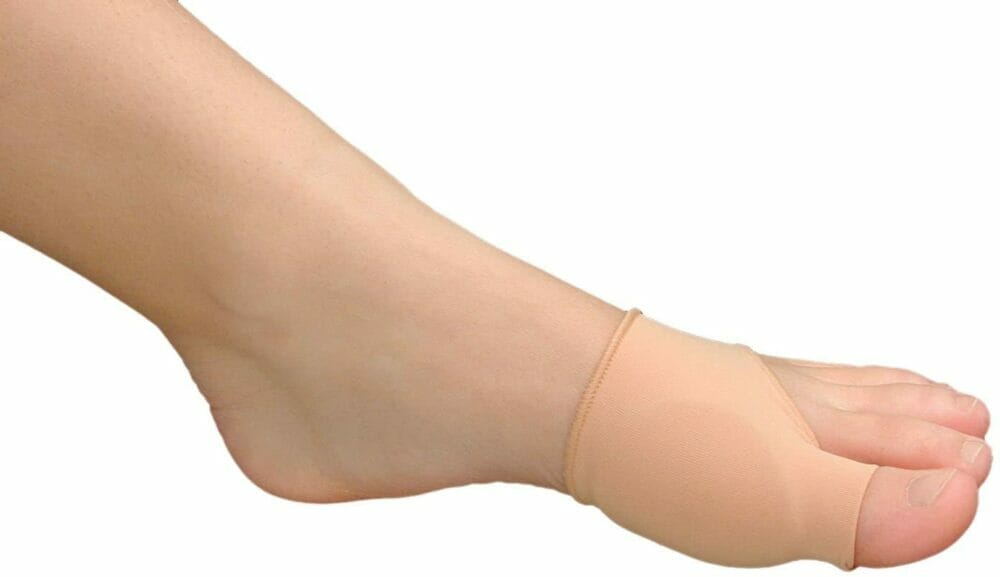
- Relieves Bunion (Hallux Valgus) Pain
- Protect against shoe pressure and friction
- Fits comfortably in your shoes
- Promotes better blood circulation
- Interchangeable for both left and right feet
- Made of soft stretch fabric and a comfortable gel pad
- Washable and reusable
Pedifix Visco-GEL Dual Action
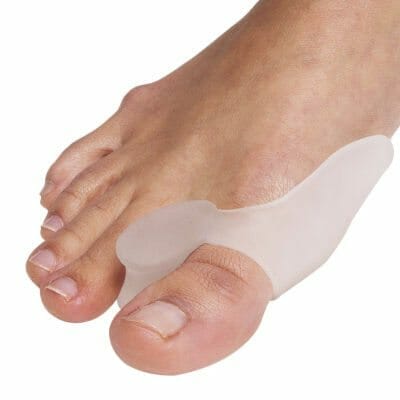
- Helps with bunion relief and toe discomfort
- Great for recovering from bunion surgery
- Safe to wear while walking, hiking, or sleeping
- Gel ring protects bunion and absorbs friction
- Helps with separation and re-alignment of the big toe
- Increase Blood circulation
- Fits comfortably under your socks and inside shoes
- Easy to use and clean
- Completely washable and reusable
- Made of durable medical-grade gel
PediFix Visco-GEL Toe Spacers
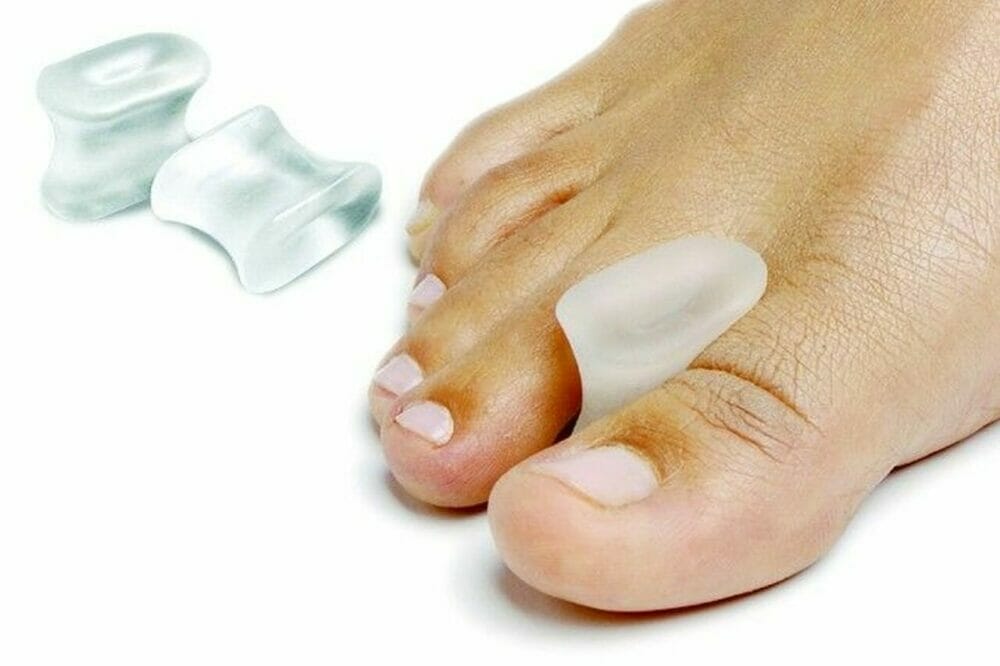
- Soft and elastic Visco-GEL
- Separates rubbing and overlapping toes
- Cushions and protects against pressure and friction
- Fits between big and second toes
- Releases vitamins and minerals to soothe skin
- Fits interchangeably on the right or left foot
- Washable and reusable
- Intended for regular use
PediFix Bunion Relievers
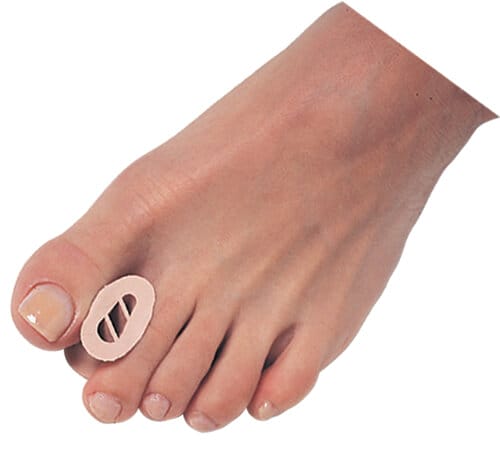
- Separate your big and second toes
- Soft Rubber Spacers to maintain proper alignment
- Helps alleviate sore bunions by reducing friction and pressure.
- Relieves Irritation between toes
- Reduces pressure on Bunion joint
- Suitable for Left or Right foot
- Made of soft and durable rubber
PediFix Pedi-GEL Bunion Shield
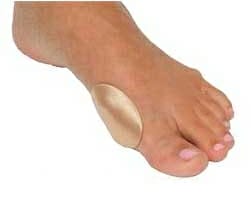
- Provides instant relief from painful bunions
- There is an inner layer of Pedi-gel in this bunion guard that absorbs friction and pressure
- Sticks firmly even after repeated uses since it is self-adhesive
- Relieves bunion while providing a cushion & protection
- Thin design, fits in all shoes and stays in place
- Durable, Washable, and Reusable
7. Bunion splints – a splint is intended to wear at night while sleeping to slow down the progress of a bunion. It helps to keep the joint stretched out to straighten the toe and prevent stiffening in the misaligned position.
Recommendations: DARCO Toe Alignment Splint, PediFix Nighttime Bunion Regulator Splint, and Pedifix Adjustable Bunion (Hallux Valgus) DaySplint
DARCO Toe Alignment Splint

- Soft elasticized cotton fabric
- Cushioned foam interior
- Special t-strap that maintains toes alignment
- 4 (four) individual soft toe loops
- Post-surgery toe alignment
- One size fits all design
- Fits right or left foot
PediFix Nighttime Bunion Splint

- Helps soothe and relieve bunion Pain
- Corrects the alignment of the big toe
- Doctor-developed splint for nighttime bunion relief
- Recommended by podiatrists as an alternative to Bunion surgery (can also be used as a post-surgical splint).
- Slows the progression of the bunion deformity
- Perfect to wear while resting or sleeping
- If desired, a sock can be worn over the splint to reduce friction while sleeping
- Available for left and right foot in different sizes
PediFix Adjustable Bunion DaySplint
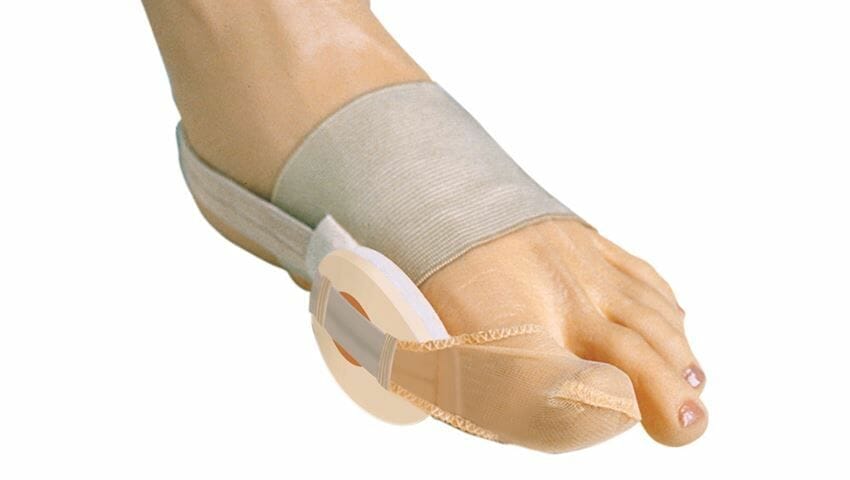
- Aligns Big Toe to Reduce Pain
- Reduces pressure on the Big Toe Joint
- Adjustable alignment control
- Permits Hallux (bunion) flexion and extension
- Improves surgical results by speeding up the bunion healing process
- Can be used either with the surgical dressing or after it is removed.
- Can be easily removed, adjusted, and re-applied.
- Fits comfortably in most shoes
- Washable and reusable
8. Moleskin padding – this product prevents bunion pain and discomfort by eliminating the rubbing between the inside of your shoe and your skin. It usually comes with an adhesive backing to stay in position for an extended amount of time.
Check out PediFix Visco-GEL Moleskin Protective Padding
PediFix Visco-GEL Moleskin Padding

- Patented Visco-GEL that moisturizes skin
- Self-adhesive sheets that stay on the skin for a long time
- Absorbs pressure and friction on foot’s soft spots
- Soft and durable moleskin fabric
- Conform to any foot contours
- Heals and prevents callus, corns, and blisters
- Washable and reusable
- 2 (two) 2.5 x 3 inches sheets trimmable to fit
9. Topical analgesics – topical analgesics come in different forms such as cream, ointment, and gel that can be applied directly on the skin. They contain the same pain relief drugs found in oral medications.
Recommendations: Biofreeze Professional Cold Therapy Pain Reliever, and FastFreeze Cooling Pain Relief Therapy
Biofreeze Cold Therapy Pain Reliever

- Fast-acting cold therapy
- Long-lasting menthol formula
- All natural ingredients
- Enhanced botanical blend
- Powerful pain relief
- Easy application and quick absorption
- Greaseless and non-staining
- Paraben-free
- Available in different sizes (up to 1 Gallon)
FastFreeze Cooling Pain Relief Gel & Spray

- Made from all-natural formula
- Delivers targeted pain relief
- Fast acting relief
- Easy to apply
- Vanishing strength
- Greaseless and stain-free
- Dries quickly
- Available in spray, roll-on, or gel tube
10. Lidocaine patches – this non-surgical bunion treatment can be purchased over the counter and is intended to provide temporary pain relief to bunions and other types of nerve pains. The patch adheres to the skin and numbs the area.
11. Arch support – regular use of arch supports relieves bunion pains and prevents inflammations as it provides the support that your foot needs for normal flexion and movement while relieving the pressure on the big toe joint.
Recommendations: Pedifix Pedi-Smart Arch Brace, and PediFix Arch Bandage
PediFix Pedi-Smart Arch Brace
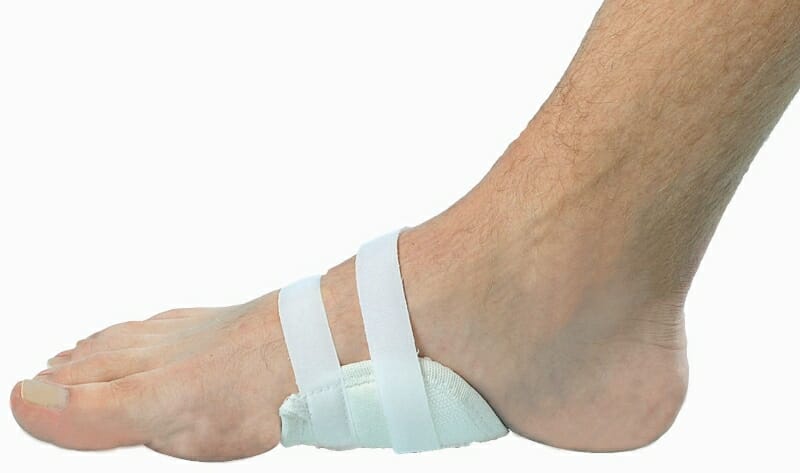
- Relieves Plantar Fasciitis pain
- Reduces tension on flat feet, heels & arches
- Comfortable and soft Terrycloth pad
- Fits securely with adjustable Velcro® straps
- Wear directly against the skin or under socks
- Designed to fit most shoes
- Provides greater comfort when walking
PediFix Arch Bandage

- Supports fallen arches and flat feet
- Reduces plantar fasciitis and heel spurs
- Soothes forefoot pain, neuroma, and bunion pain
- Thin and soft elastic fabric that fits in most shoes
- Provides foot balance and stability
- Prevents knee, hip, and back pains
- Washable and reusable
- Can be worn on either left or right foot
12. Steroid injections – also known as cortisone injections, this treatment can temporarily relieve bunion pain by reducing inflammation, but should NOT be used frequently. It is formulated using corticosteroid medication and a local anesthetic. Prolonged use of steroid injections can damage the soft tissues of the foot, thinning the skin and joint capsule.
13. Stem cell therapy – stem cell therapy can also be used to treat bunions and other foot injuries and conditions. This minimally invasive treatment has minimal side effects (minor swelling or pain on the injection site) and is suitable for most patients.
14. Ice therapy – icing your bunion can help relieve its soreness and swelling, especially if you have been on your feet for so long. Apply ice in the area for a few minutes, and do it consistently to reduce the inflammation.
15. Custom orthotics – these are prescription medical devices that individuals with bunions wear. These devices work by correcting the foot’s biochemical issues such as straightening and aligning your toes. A customized orthotic device prescribed by your doctor can help relieve pain and compensate for a toe joint deformity.
When do you need bunion surgery?
If your bunion inflammation becomes too painful that it affects your day-to-day life and all the non-surgical treatments were not able to relieve it, you may consider getting bunion surgery. Consult with your doctor to check your bunion condition and advise on the type of surgery that is right for you.
What are the different types of bunion surgeries?
The traditional bunion surgery method is also known as metatarsal osteotomy or bunionectomy. There are various techniques that surgeons use for this surgery, but all of them involve cutting the bones and using metal screws to reposition them. Among these techniques are:
Exostectomy – this involves shaving off the bunion from the affected foot. This procedure is rarely done and is only applicable to minor bunions.
Arthredosis – this procedure is mostly done with severe bunions. It involves removing parts of the big toe joint that have arthritis and placing screws in the toe to hold the bones together.
A minimally invasive bunion surgery, on the other hand, is performed by using a burr to cut the bone through the tiny incisions made through the skin of the patient’s foot.

Photo by BruceBlaus – Own work, CC BY-SA 4.0, Link
Traditional Bunion Surgery vs Minimally Invasive Surgery
All traditional surgery involves cutting the bones and using screws, therefore it is more painful and will take a longer time to recover. However, it is a more powerful option for patients who have severe foot deformities due to bunion. It also reduces the risk of severe bunion recurrence.
Minimally invasive surgery, on the other hand, uses small incisions so it provides better cosmetic results. It also involves less pain and a shorter recovery time so the patient will most likely require less medication and be able to get back in regular shoes within a short period.
How painful is bunion surgery?
Any type of surgery is generally painful, more so if a large foot surgery will be performed on you. The good thing is that a local anesthetic will be given to you so you will not feel any pain while the surgery is performed. You will also be given a sedative to feel more relaxed and comfortable.
How long does it take to recover from bunion surgery?
Your recovery time will depend on the type of surgery performed on you as well as your overall health and other factors. The initial recovery period may last for about six months and complete recovery might take a year. But to help you get on your foot as soon as possible, your surgeon may recommend physical therapy to help strengthen your foot muscles and improve your mobility.
Recovery from minimally invasive bunion surgery
Minimally invasive bunion surgery will require less time for recovery. You can bear full weight almost immediately as soon as the feeling in your foot is restored. You might only need around two weeks to decrease the swelling and heal all the wounds. Within this period, you will be required to limit activities and keep your feet elevated most of the time.
After that, your doctor might prescribe you a post-operative splint for toe alignment while you are gradually getting back to your normal activities.
Do bunions grow back after surgery?
Even after successful surgery, there is still a possibility that your bunion will return. Studies have reported that around 25 percent of patients who have undergone surgery experience regrowth of their bunion. Patients with over 40 degrees or larger preoperative hallux valgus angle (angle formed by the toe bone and first metatarsal bone) have a higher risk of bunion recurrence.
How can you prevent a bunion from growing back?
Although bunions can still return, there are steps you can do to prevent them from coming back. This includes getting physical rehabilitation, changing your lifestyle, and using custom orthotics or removable splints.
Before trying out one of them, it is crucial to consult with your podiatrist so he can advise on the best method to suit your lifestyle, needs, and relevant restrictions. Take your podiatrist’s advice seriously so your bunion would less likely to regrow.
Consider Preventative Bunion Treatments
The best way to cure a bunion is to prevent it from growing in the first place. While bunion is hereditary and some people are more prone to having it, this condition develops slowly so taking good care of your feet since childhood or early adulthood can reduce or slow down the likelihood of having a painful bunion when you grow older.
Make sure to keep track of the shape of your feet, exercise your feet regularly, wear well-fitted shoes and avoid shoes with high heels and pointed toes, and don’t cramp your toes. These preventive measures along with regular check-ups from your podiatrist can pay off later in life.
Conclusion
There are various treatments available for bunions without having to go through surgery. By simply changing the way that you walk, wearing comfortable shoes, and using various at-home bunion remedies, you can minimize the pain and discomfort associated with your condition. So don’t suffer any longer – give these tips a try and see which ones work best for you!
Speaking to your podiatrist about these treatments can also help you make the best decision when it comes to relieving or managing your bunion condition. For your convenience, you may speak with a doctor online here to get instant answers to your questions.
FAQs: Bunion Pain and Treatments
What is bunion pain?
Bunion pain is a type of pain that is typically associated with the development of bunions. Bunions are a condition where the big toe starts to point inward, towards the second toe. This can cause the joint at the base of the big toe to become enlarged and protrude outwards. The skin over the bunion may also become irritated and red. Bunions can be painful and make it difficult to wear shoes.
What are Tailor’s Bunions?
A Tailor’s Bunion, also known as a bunionette, is a deformity of the fifth metatarsal bone at the little toe. This deformity can cause the little toe to turn inward (medially) towards the fourth toe, and may cause the fifth metatarsal bone to protrude outward (laterally).
The condition is caused by repetitive motion and pressure on the feet, which can lead to the formation of a bony lump on the side of the foot. Tailor’s bunions can be painful and can make it difficult to wear shoes. Treatment typically involves wearing comfortable, supportive shoes and avoiding aggravating activities.
How can you prevent Tailor’s Bunions?
There are several ways to prevent Tailor s Bunions.
1) First, avoid tight-fitting shoes or clothing.
2) Second, take breaks throughout the day to stretch and move around.
3) Third, use a bunion pad or splint to help reduce pressure on the bunion.
4) Fourth, avoid activities that put excessive stress on the foot, such as high-impact sports. Finally, see a podiatrist for regular checkups and to discuss any concerns you may have.
What are the causes of bunion pain?
There are a number of possible causes of bunion pain. One is that the big toe joint may be slowly deteriorating due to arthritis. This can lead to pain and stiffness in the joint. Another possibility is that the tendons and ligaments around the big toe joint may be tight or stretched, which can also cause pain. Bunions can rub against shoes, which can cause discomfort. Additionally, the bunion itself may be pressing on nerves or blood vessels, which can cause pain or numbness.
Are stilettos to blame for the bunion?
Some experts believe that stilettos are to blame for the development of bunions, while others believe that bunions are simply a matter of genetics and cannot be blamed on any specific type of shoe. However, it is widely accepted that tight, constrictive footwear can contribute to the development of bunions. Stilettos are a type of footwear that often fits snugly and puts pressure on the front of the foot, which can exacerbate existing bunion deformities or contribute to the development of new bunions.
What are the treatments for bunion pain?
There are a few different options when it comes to treating bunion pain. One option is to wear special shoes or pads that help to relieve pressure on the bunion. Another option is to have surgery to correct the deformity. Surgery is usually only recommended if other methods of treatment haven’t worked or if the pain is severe. In some cases, medication may be prescribed to help relieve pain and inflammation.
What are the Bunion Stage-One Treatment Options?
There are several treatment options available for stage-one bunions. These include:
1) Wearing shoes that fit properly and do not put pressure on the bunion.
2) Putting a pad or cushion on the bunion to relieve pressure.
3) Exercising the foot to strengthen the muscles around the bunion.
4) Taking anti-inflammatory medication to reduce pain and swelling.
What are the Bunion Stage-Two Treatment Options?
There are several treatment options available for stage-two bunions. These include:
1) Surgery – This is usually the last resort, as it is invasive and can be quite expensive.
2) Orthotics – These are devices that can be inserted into your shoes to help realign your foot and relieve pressure on the bunion.
3) Use Bunion Padding and strapping.
What are the Bunion Stage-Three Surgical Treatments?
There are several surgical treatments available for stage-three bunions. The most common is a procedure called a bunionectomy, which involves removing the bunion and realigning the bones in the foot. This can be done either through an incision in the skin or by using endoscopic techniques, which are less invasive but require more recovery time.
What are the risks associated with bunion pain?
There are a number of risks associated with bunion pain. Firstly, if the pain is left untreated, it can lead to further deformity of the foot and the development of other problems such as arthritis. Other risks associated with bunion pain include but are not limited to: joint damage, metatarsalgia (pain in the ball of the foot), and hammertoe.
Bunion pain can also cause difficulty with walking and other activities and may lead to falls or other injuries. Additionally, bunions can be very painful, making it difficult to wear shoes or participate in activities.
What is the best way to treat a bunion?
There is no definitive answer to this question as the best way to treat a bunion will vary depending on your individual case. However, some common treatments for bunions include wearing shoes that fit properly and provide adequate support, using pads or other devices to cushion the bunion, and undergoing surgery to correct the deformity. In all cases, it is important to consult with a medical professional in order to determine the best bunion treatment for your condition.
Can orthotics help treat bunions?
There is some evidence that orthotics can help treat bunions by reducing the pressure on the joint. This can help to slow the progression of the deformity and reduce pain. However, orthotics cannot completely reverse a bunion deformity. Surgery is often necessary to fully correct severe bunions.
How can I shrink my bunions naturally?
There are a few things you can do to shrink your bunions naturally. First, try to avoid any activities that put unnecessary stress on your feet, such as standing for long periods of time or wearing high heels. Second, make sure you’re wearing comfortable shoes that fit properly and offer support. Third, try using some home remedies to reduce inflammation and pain, such as applying ice or taking over-the-counter anti-inflammatory medication.
How much does bunion surgery cost?
The cost of bunion surgery will vary depending on the severity of the deformity and the type of surgery that is required. In general, bunion surgery can cost anywhere from $2,000 to $5,000 in the United States.
Will bunions come back after surgery?
The short answer is yes, bunions can come back after surgery. However, the chances of this happening are relatively low. There are a number of factors that contribute to the likelihood of a bunion returning, including the type of surgery performed, the degree of deformity present before surgery, and the patient’s post-operative care.


